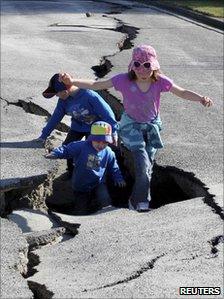New Zealand earthquake 'damaged 100,000 homes'
- Published

Despite the widespread damage caused by the earthquake, no-one was killed
Almost two-thirds of the 160,000 homes in and around Christchurch have been damaged by Saturday's earthquake, New Zealand's prime minister has said.
John Key said many had been damaged beyond repair, and that it might take some time to discover the damage to the region's underground infrastructure.
A state of emergency in Christchurch has been extended until Wednesday, and the city centre remains cordoned off.
Experts have warned a major aftershock could rock the area in the near future.
More than 80 aftershocks have been recorded since Saturday's 7.0-magnitude tremor, the strongest of which had a magnitude of 5.1.
"It is still possible that we'll have a magnitude 6 in the next week, and people ought to be aware of that, particularly if they are around structures which are already damaged," Ken Gledhill of the Institute of Geological and Nuclear Sciences told the NZPA news agency.
"For a shallow earthquake like this, they will go on for weeks," he added. "And if a building is badly damaged, it won't take much shaking to push it over."
Despite the widespread damage caused by the strong earthquake, no-one was killed and only two serious injuries were reported.
'Miraculous'
Mr Key, who visited earthquake-stricken parts of the country's South Island over the weekend, said 430 houses and another 70 buildings had already been earmarked for demolition by assessment teams.
About 100,000 of the 160,000 homes in the Christchurch, Selwyn and Waimakariri areas had sustained some damage, he added.
"I was awe-struck by the power of the earthquake and the damage it has caused in the city," he told reporters. "It was miraculous that nobody was killed."

Schools will remain closed for the next two days to allow safety checks
The cost of repairs has been estimated at NZ$2bn ($1.44bn; £930m). Most households and businesses were expected to claim from their insurers and the Earthquake Commission (EQC), officials said.
Mr Key said the central government planned to provide at least 90% of the funds needed to rebuild the area's water, sewerage and road networks, the overall damage to which had yet to be fully assessed.
"The above-ground damage is obvious, but it could take some time to understand just how much damage there is to underground infrastructure."
The prime minister said the earthquake would have a short-term negative impact on economic growth, but that the loss "would be more than made up by the stimulus impact that takes place with the rebuilding programme".
'Sagging' spirits
Meanwhile, Christchurch mayor Bob Parker extended a state of emergency for another two days as troops were deployed throughout the city to help police secure streets and badly damaged businesses.
A second nighttime curfew to protect against looting was lifted on Monday at 0700 (1900 GMT Sunday), while another is planned for Monday night.
About 200 people whose homes were damaged spent the night in shelters.
Power has been restored to 90% of the city, and the water supply has resumed for all up to 80%. Those with running water have been warned not to drink it because of contamination from broken sewage pipes.
"You have to boil your water very carefully," resident Oriana Toasland told the BBC. "You're not allowed to flush the toilet because there are problems with the sewers. So we don't know how long this is going to go on for as well."
Schools will remain closed for the next two days to allow safety checks.
Some residents told the BBC that there had been delays in getting officials to assess the damage to their houses, and basic foodstuffs were in short supply.

Mr Parker told the BBC that the magnitude of the destruction had only now dawned on the city's 386,000 residents.
"It's now into the third day since the quake and that initial adrenalin has been replaced by a great deal of tiredness," he said.
"People's spirits in some ways are starting to just sag a little more as the reality of what's in front of all of us really comes back. What about the job? What about the business? What about the schools? When is this going to be fixed, when will life get back to normal?" he added.
New Zealand lies at the southern end of the so-called Pacific Ring of Fire, and above an area of the Earth's crust where the Pacific Plate converges with the Indo-Australian Plate.
The country experiences more than 14,000 earthquakes a year, of which only about 20 have a magnitude in excess of 5.0.
The last fatal earthquake was in 1968, when a 7.1-magnitude tremor killed three people on the South Island's western coast.
- Published3 September 2010